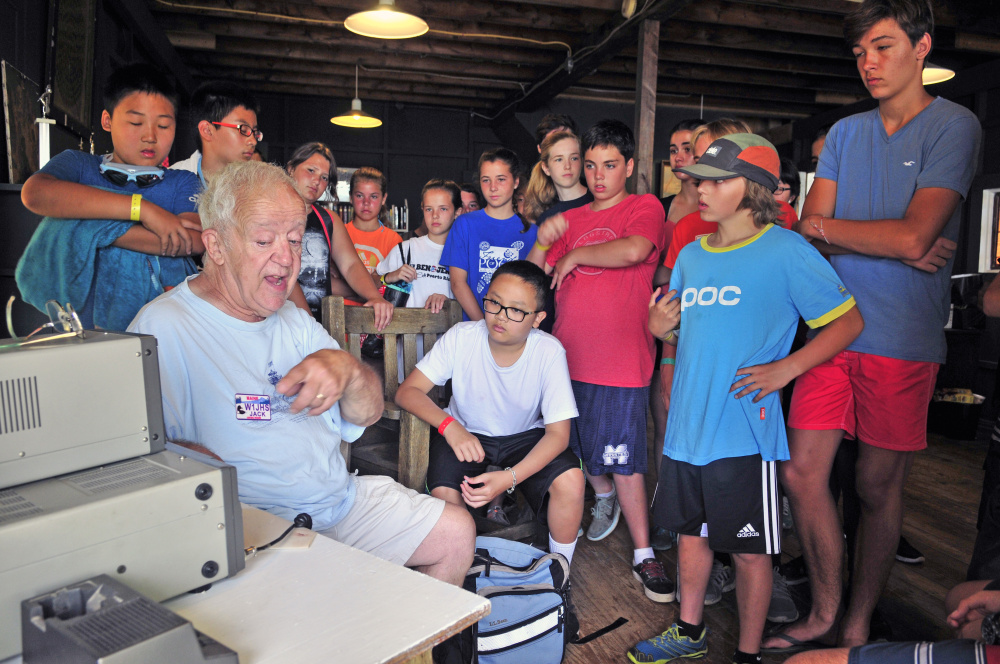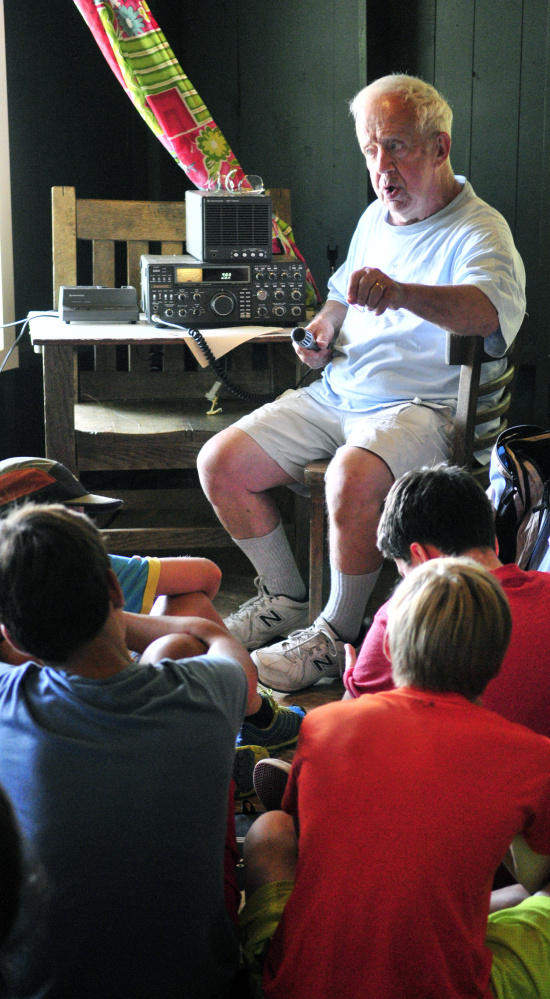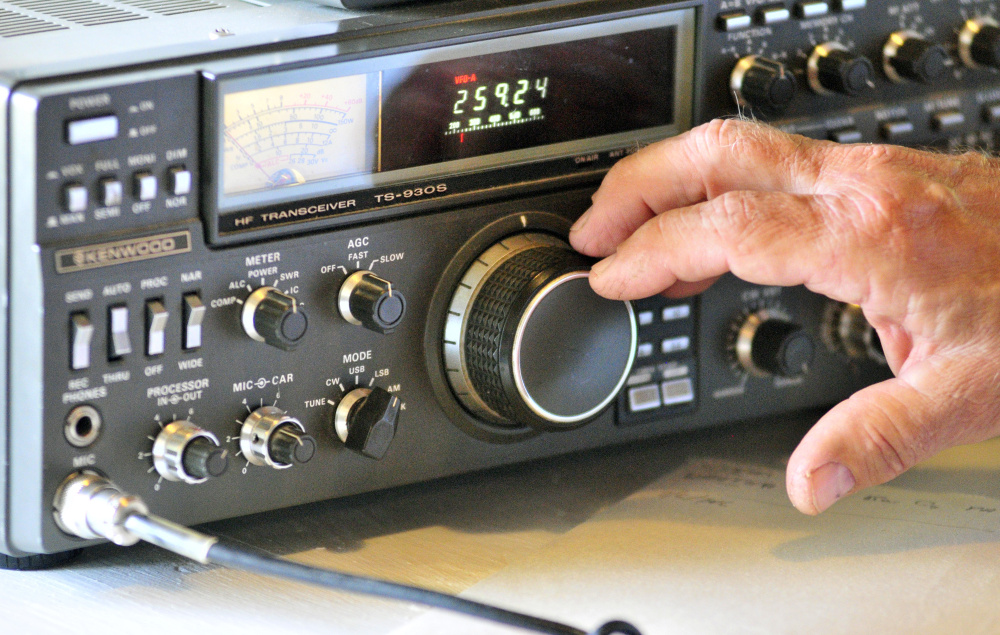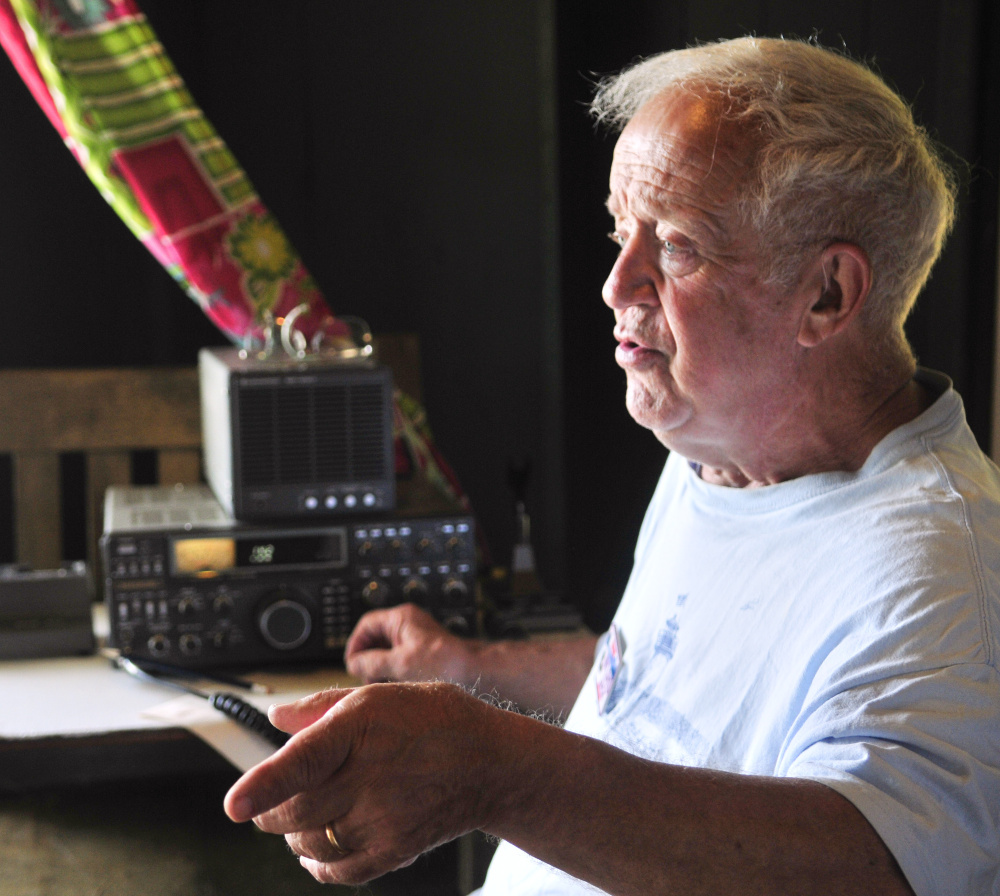WINTHROP — The looks on the faces of the 30-plus YMCA campers ranged from curiosity and intrigue to apathy and amusement as they listened to Jack Schrader scan the amateur radio frequency spectrum Wednesday morning.
After nearly 45 minutes, a connection was made with a manure farmer more than 500 miles away.
Schrader, an amateur radio operator, or ham, spent nearly an hour explaining the “dying art of amateur radio operation” to a group of kids at the YMCA Camp of Maine in Winthrop.
“We try to make the kids aware that there’s something out there more than just cellphones and tablets,” Schrader said before the library cottage building became filled with campers. “It’s a lost art, a dying art, and I want to keep it going.”
Schrader, who lives across Cobbossee Lake in Manchester, explained that despite clear blue skies, the conditions weren’t great for communicating by ham radio, which didn’t make much sense to anyone else in the room.
Schrader explained that the ionosphere, a layer in the Earth’s atmosphere that reflects radio waves, lies in a range of 80 to 300 miles above the Earth’s surface, and when the sun shines, it changes the height and composition of the ionosphere, thus affecting its ability to send radio waves back to Earth.
“I think maybe I’ve seen it before, but I don’t know,” said 12-year-old Alan Nguygen, an incoming eighth-grader from Kennebunk. “It must’ve been hard to use these in the past especially if you didn’t know what you were doing.”
He said he thinks people would like to use ham radios to stay connected to friends and family, especially if there wasn’t any power or cellphone service.
Amateur radios are used for many different reasons, Schrader said, including communicating about the weather, local outdoor conditions, emergency situations and just for friendly conversation. Schrader — known by his ham radio call sign W1JHS — said he’s spoken to people all over the world since he first started using an amateur radio in 1977.
“I had someone I connected with in Perth, Australia, which is about as far away from Maine as you can get in either direction,” he said. “It has been used by people from all over the world, and even well-known people like Barry Goldwater, King Hussein of Jordan and Arthur Godfrey.”
After listening to random conversations about muggy conditions in West Virginia and North Carolina for close to an hour, Schrader joined a conversation with a man named Victor, who lives on a farm in the Appalachian foothills of Pennsylvania.
Schrader and Vic, who said his call sign too fast for anyone other than Schrader to pick up, went back and forth for several messages about the demonstration Schrader was giving to the kids and about the continued use of ham radios technology.
“You know, we’ve got no wires and no cables, it’s just us,” Vic said. “Glad we were able to demonstrate what we can do with just the sun and the ionosphere.”
Using a Kenwood radio from the 1980s, Schrader told the voice from Pennsylvania that he was operating remotely from a summer camp outside of Augusta, Maine. Vic, familiar with the type of equipment Schrader has at home, which includes several other radios and towers and antennas, was impressed that Schrader was able to link up lakeside in order to show the kids how this technology works.
“I’ve never seen anything like it in person,” said camp lifeguard Will Boothby, 17, of Washington, D.C. “It was like something I’ve seen in a movie.”
To become a ham operator, a person must pass a test and obtain a Federal Communications Commission license. The federal government began regulating amateur radio in the early 1900s, and the FCC, which still governs it today, took charge in 1934.
The FCC’s website says the agency established amateur radio as a voluntary, non-commercial, radio communications service. Schrader, who spent a good part of his career working as a digital technician, said he just likes talking and communicating with people.
Schrader explained to the campers how ham radios were used in New Orleans during Hurricane Katrina.
According to Sean Kutzko, the media and public relations manager for the non-profit American Radio Relay League, the national association for amateur radio, there are more than 743,000 licenses across the country and more than three million ham radio operators worldwide. In Maine, there are nearly 20 ham radio clubs, including the Augusta Amateur Radio Association and the Waterville Area Wireless Association.
“The trend has been upward since 2006, and we are seeing steady growth of about 2 percent per year,” Kutzko said. “We are more popular than ever.”
Jeff Gleason, the CEO of the YMCA Camp of Maine, said it’s great that the government still supports the use of these radios and thinks it’s a worthwhile thing for campers to learn about.
“I think it really opens up their minds to the way things used to be and that there is still technology we use today that exists from a long time ago,” Gleason said.
Jason Pafundi — 621-5663
Twitter: @jasonpafundiKJ
Send questions/comments to the editors.







Success. Please wait for the page to reload. If the page does not reload within 5 seconds, please refresh the page.
Enter your email and password to access comments.
Hi, to comment on stories you must . This profile is in addition to your subscription and website login.
Already have a commenting profile? .
Invalid username/password.
Please check your email to confirm and complete your registration.
Only subscribers are eligible to post comments. Please subscribe or login first for digital access. Here’s why.
Use the form below to reset your password. When you've submitted your account email, we will send an email with a reset code.